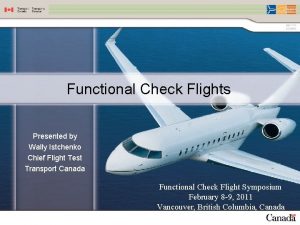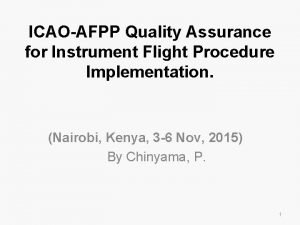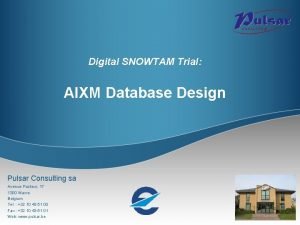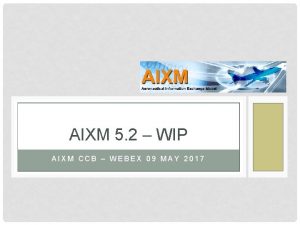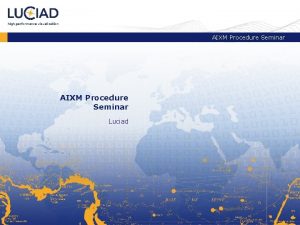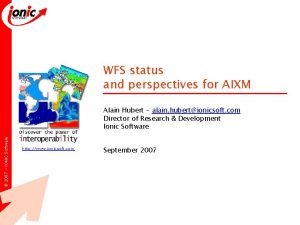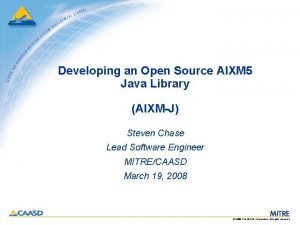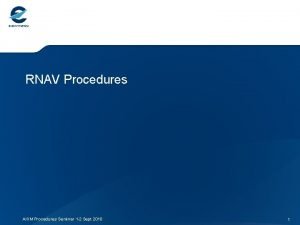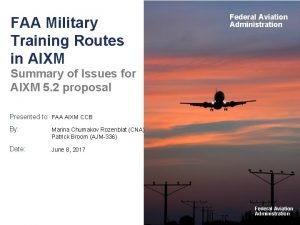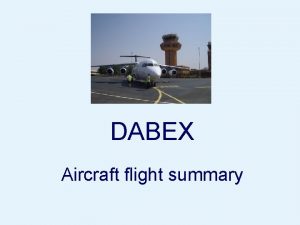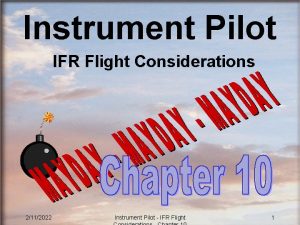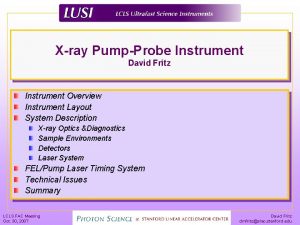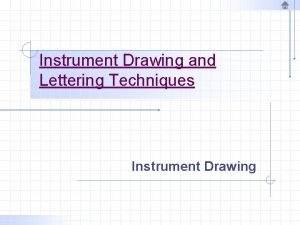Implementing AIXM in Instrument Flight Procedures Automation AIXM











- Slides: 11

Implementing AIXM in Instrument Flight Procedures Automation AIXM Users’ Conference March 18 -20, 2008 Washington, DC Presenter: Iain Hammond AIXM Users’ Conference, & 18 -20 March 2008 Ltd Mac. Donald, Dettwiler Associates 1

Introduction • The Instrument Procedure Development System (IPDS) and selected FAA databases were successfully integrated using web services and AIXM 5. 0 RC 3 in mid-Feb 2008. • Key Implementation Decisions 1. Used XSLT technology rather than data binding to reduce code base, and improve maintenance agility. 2. Used standard query & filter models to generalize the interface to AIXM features: • • Open Geospatial Consortium (OGC) Web Feature Service (WFS) Open. GIS® Filter Encoding. 3. Extended AIXM model for FAA instrument flight procedure processes. 4. The use of Xlink associations - were the most challenging aspect of AIXM 5. 0 to implement. AIXM Users’ Conference, 18 -20 March 2008 2

Instrument Procedure Development System (IPDS) • IPDS automates the design of Instrument Flight Procedures (IFPs), and is a key component of the FAA Instrument Flight Procedures Automation (IFPA) program. • IPDS supports multiple temporal statuses for each piece of data. • User “pulls” data from distributed databases federated under a serviceoriented architecture (SOA). • IFP design is performed in local ‘Work Area’ that provides a spatial view of data. • New and updated data is “pushed” back to FAA databases through web services. AIXM Users’ Conference, 18 -20 March 2008 3

IPDS Aeronautical Data Interfaces • FAA Service Providers expose aeronautical data through web services in an SOA that hides the actual database structure from the service users. AIXM Users’ Conference, 18 -20 March 2008 4

XSLT Used for Data Transforms • On either side of each interface, AIXM transformation from / to internal representation is isolated to minimize the impact on the applications from changes to data exchange formats. • On output, AIXM-5 is generated via XSLT transform on the internal model. • On input, AIXM-5 is similarly transformed by an XSLT. • XSLT selected over a data binding approach for: • A smaller code base • Agility to react to changes in data models on either side of the interface. AIXM Users’ Conference, 18 -20 March 2008 5

Generalized Queries Using Industry Standards • Adopted a generic web feature service query model rather than defining individual and data specific queries, based on: OGC Web Feature Service (WFS) Implementation Specification • Open. GIS® Filter Encoding Implementation Specification. • • The model provides a generalized interface to all AIXM feature data: Consistent with OGC standards • Specified through a system-neutral query filter that can be transformed into SQL or XPath to fetch data. • • A generalized WFS request (get. Feature) specifies: feature type, output format, and a filter to define scope of the query: <Get. Feature. Request Encoding="UTF-8" Compress. Data="OPTIONAL"> <wfs: Get. Feature output. Format="text/xml; subtype=gml/3. 1. 1 “ result. Type="results" traverse. Xlink. Depth="0"> <wfs: Query type. Name="aixm: Airport. Heliport"> <ogc: Filter> <ogc: BBOX> <ogc: Property. Name/> <gml: Envelope srs. Name="epsg: 4326"> <gml: lower. Corner>38. 20527 -73. 574472</gml: lower. Corner> <gml: upper. Corner>41. 53861 -76. 907805</gml: upper. Corner> </gml: Envelope> </ogc: BBOX> </ogc: Filter> </wfs: Query> </wfs: Get. Feature> </Get. Feature. Request> Example Query by Bounding Box AIXM Users’ Conference, 18 -20 March 2008 6

Generalized Queries Using Industry Standards • • The WFS implementation enables an allowable set of filter properties to query data by criteria: • Spatial bounding box • Country, State, Province • Identifier and/or designator, with wild card queries • Production status (e. g. , active, pending) • Effective date • Last modified date. AIXM messages for spatial queries can be very large, so to reduce message size: • XML response message are not indented (saves transmitting white space) • XML response is compressed to reduce data transfer & memory requirements. AIXM Users’ Conference, 18 -20 March 2008 7

AIXM 5. 0 Extensions for IFP Design • AIXM 5. 0 does not support all FAA Instrument Flight Procedure design needs. • The schema was extended using the AIXM 5. 0 extensions model to support additional elements and capabilities: Production and Workflow elements • FAA-specific data elements for procedure design • Structured annotations on any feature by extending the AIXM Note object • File metadata elements for the capability to associate and store file attachments on any feature. • • Extensions are modelled in UML; and the XML schema generated by the FAA from the UML model. AIXM Users’ Conference, 18 -20 March 2008 8

Feature Identifiers and Associations • Xlinks are a challenging aspect of AIXM 5. 0: As a concept for the developers • In practice, for example accessing and navigating the XPath query fragment in XSLT. • • The Xlink attributes are set in AIXM generation: The href is set to the XPath of the AIXM gml: identifier UUID of the referenced feature • The title is set to the ‘natural key’ of the referenced feature, to provide a human-readable link that helps debugging. • <serves_Runway. Direction xlink: href=“http: //www. faa. gov/avnis? //aixm: Runway. Direction. Time. Slice [. . /gml: identifier[@code. Space='http: //www. faa. gov/avnis'] ='uuid 0123' and (aixm: extension//dpshare: revision='2')]” xlink: title = "//aixm: Runway. Direction//aixm: designator='27' and //aixm: Airport. Heliport//aixm: designator='KDEN'"/> AIXM Users’ Conference, 18 -20 March 2008 9

Summary • IPDS and existing FAA databases are successfully integrated using web services and AIXM 5. 0 RC 3. • IPDS now provides browsing and querying FAA data sources in AIXM 5. 0 format. • Open industry standards used to simplify maintenance. • AIXM 5. 0 model was extended to support FAA IFP processes. • Next IPDS release will extend the scope of AIXM 5. 0 data exchange to include more feature types, data sources and the “push” of data into the distributed data enterprise AIXM Users’ Conference, 18 -20 March 2008 10

Questions Mac. Donald, Dettwiler and Associates Ltd. http: //www. mdacorporation. com/ AIXM Users’ Conference, 18 -20 March 2008 11

